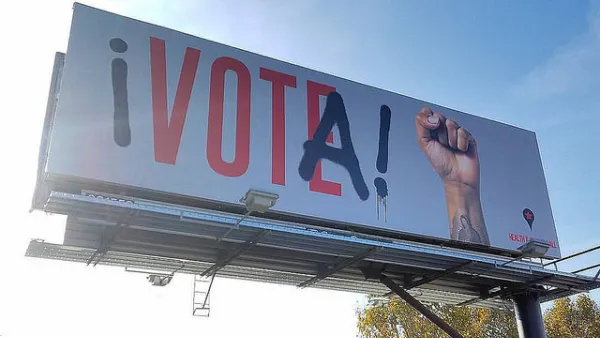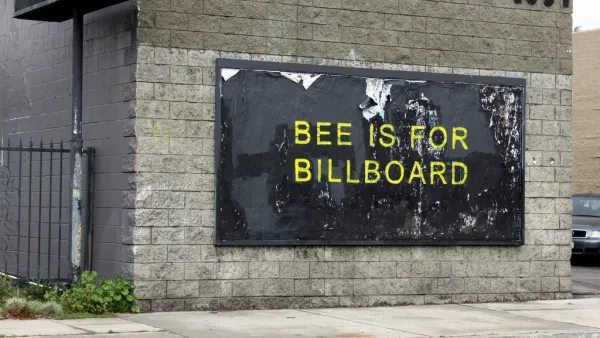I missed the APA national conference for the first time in 15 years -- but I quickly heard reports that one of the hot topics focused on banning electronic message boards. I dissent. What would Times Square be without the colorful, multi-message, oft-changing signs? Would Las Vegas have become the tourist definition that it has without the colorful signs? I am not a huge fan of Las Vegas, but I certainly think it has the right to define itself as it wishes.
I missed the APA national conference for the first time in 15 years -- but I quickly heard reports that one of the hot topics focused on banning electronic message boards. I dissent.
What would Times Square be without the colorful, multi-message, oft-changing signs? Would Las Vegas have become the tourist definition that it has without the colorful signs? I am not a huge fan of Las Vegas, but I certainly think it has the right to define itself as it wishes.
I have spent a lot of time on this issue over the last several years. The evidence is mixed, but I am convinced that signs distract drivers from their primary task and that rapidly changing messages distract drivers more than static ones. Our local zoning board somehow granted a variance to allow the conversion of an ill-placed billboard with a frequently changing electronic board that I can see from my family room window, and I hate it (the good news for the community is that there was a massive protest at the next request for such a variance and the board seems to have decided to stop giving them).
Rapidly changing signs do not belong everywhere. I do not like to see them on busy sections of highway with complex traffic patterns. They bother me less along open stretches of road passing small communities, but that is an aesthetic judgment on my part. They certainly do not belong in neighborhoods (as the one near me is). But as we attempt to recapture the vitality of our downtowns, it is worth looking back at old photos to see the movie marquees with exposed bulbs and simulated motion from changing neon tubes. Those and other lively signs helped to establish the character of our downtowns. Electronic message boards are simply a new technology for accomplishing the same effect. Are they a potential traffic hazard downtown? Think about Times Square. The only people who drive through there fast are taxis, whose drivers are no doubt inured to the sights. Similarly, in a vital downtown area traffic speeds should be somewhere between slow and modest. Although traffic can move at a decent speed on the Las Vegas Strip, traffic light cycles there are measured in minutes, not seconds -- allowing strangers plenty of time to watch a message cycle.
But electronic message boards simply represent a particular technology. Have you ever watched someone changing the gas prices on a traditional pole sign? They either teeter on ladders or juggle long poles with grabbers on the end. Either alternative has significant risks for the employees involved -- and the results are often letters that are crooked or mis-spaced, resulting in a cluttered look. Why on earth would we oppose the replacement of this old, messy and labor-intensive technology with a modern tool?
There are four real issues with electronic message boards: 1) location -- they ought to be allowed only in downtown areas and auto-oriented commercial districts; 2) size -- I have written many ordinances limiting the size of such signs to anything ranging from 20 to 120 square feet -- such limits preclude fully electronic billboards but allow the neighborhood drug store or grocery to announce specials and allow gas stations to use the technology; 3) brightness -- most if not all of the new electronic signs can be set to dim at night, when the brightness can be particularly obtrusive -- local ordinances should require that; and 4) frequency of changes -- allowing a change once per minute allows time and temperature signs (without reference to content) but precludes the rapid changes of message that can be particularly distracting. The industry pushes for 6-second or 8-second intervals; although those seem better that full motion, I think studies in the long range will show that they are just as distracting as full motion signs.
We are planners. We are presumably good at analyzing complex problems. We should certainly be able to parse an issue as simple as an electronic sign and address the specific issues that it raises rather than banning the technology. Some communities may choose to ban these signs, just as some communities ban exposed neon or signs containing colors. That is their choice. As a profession, however, and as individual professionals, we ought to help our communities make informed, context-sensitive decisions about such complex subjects.

Analysis: Cybertruck Fatality Rate Far Exceeds That of Ford Pinto
The Tesla Cybertruck was recalled seven times last year.

National Parks Layoffs Will Cause Communities to Lose Billions
Thousands of essential park workers were laid off this week, just before the busy spring break season.

Retro-silient?: America’s First “Eco-burb,” The Woodlands Turns 50
A master-planned community north of Houston offers lessons on green infrastructure and resilient design, but falls short of its founder’s lofty affordability and walkability goals.

Test News Post 1
This is a summary

Analysis: Cybertruck Fatality Rate Far Exceeds That of Ford Pinto
The Tesla Cybertruck was recalled seven times last year.

Test News Headline 46
Test for the image on the front page.
Urban Design for Planners 1: Software Tools
This six-course series explores essential urban design concepts using open source software and equips planners with the tools they need to participate fully in the urban design process.
Planning for Universal Design
Learn the tools for implementing Universal Design in planning regulations.
EMC Planning Group, Inc.
Planetizen
Planetizen
Mpact (formerly Rail~Volution)
Great Falls Development Authority, Inc.
HUDs Office of Policy Development and Research
NYU Wagner Graduate School of Public Service





























